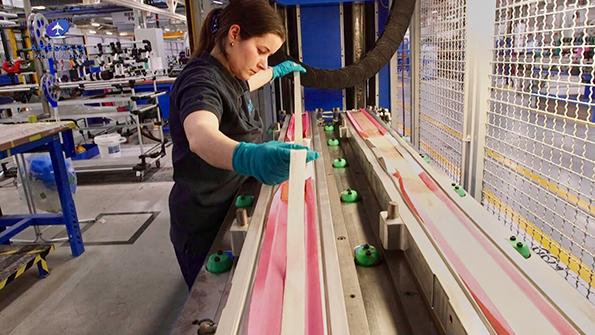
While the French aerospace industry has long experienced difficulties hiring to meet its needs in production, the problem has become more acute at the tail end of the COVID-19 crisis. As production is ramping up and projects for environmentally friendly aircraft firm up, GIFAS, the sector’s lobbying association, has stepped up its promotion efforts by launching a publicity campaign that especially targets young people and women, as well as experienced workers considering a career change.
- Airbus, Rafale production rates growing fast
- Promotion campaign strives to rekindle interest for aerospace
On GIFAS’ dedicated website for the recruitment project, a video describing the job of laying up composite material for helicopter blade manufacturing combines key messages the industry is striving to convey.
Jennifer, the featured worker, describes the main steps of the work—both techno-geeks and cooking enthusiasts will have their attention caught, thanks to the vocabulary she uses—and she points out what is at stake in the final product: flight safety. In addition, she notes Airbus Helicopters arranged the work-based training program.
In short, the video is one of the tools GIFAS is using to prevent recruitment from becoming a stumbling block in an otherwise promising period. “Since last fall, employment agencies have been telling us they see a shrinking breeding ground for us,” says Philippe Dujaric, GIFAS’ director of social affairs and training. “And our members have been alerting us: ‘When we have vacancies in production, we cannot find anybody.’”
In France, unemployment has been significantly cut in recent years, to just over 7%, according to the national statistic institute Insee. The evolution has favorably affected the younger categories of workers, making it easier for them to find a job. Apprenticeship programs have been increasingly successful, notably thanks to generous government subsidies.
At the same time, the crisis has deeply altered the employment market. “Many have found new projects or even turned away from employment,” Dujaric adds.
In the aerospace industry, two simultaneous trends have harmed the industry’s attractiveness. When production was halved, training programs had to be interrupted. And doubt crept into minds because of climate concerns, Dujaric says.
More recently, unease across the industry has combined with a preexisting lack of an appetite for technical jobs, he says. The industry has also long struggled with misrepresentation. Too many students and their parents think working conditions in a factory have not changed for the past 100 years, executives in the industry point out. Exacerbating the situation is many job names—welder and fitter, for example—are the same as decades ago. Even worse, the French word for sheet metal worker translates to cauldron-maker.
Meanwhile, strong demand in the industrial labor market is reinforcing tension. Most sectors have put the “help wanted” sign on. As a result, aerospace now has to compete with naval construction, railways, energy and other branches. In other words, sheet metal workers, welders and fitters have too much to choose from.
Such an environment makes it difficult for aerospace to fill the 15,000 vacancies planned for this year—a high level, albeit not a record number, according to GIFAS data.
The vacancy gap results from growing production rates, themselves the outcome of brisk sales. The most salient developments occurred with Airbus’ A320 family and Dassault Aviation’s Rafale fighter. Airbus plans on raising the A320’s production rate to an unheard-of 75 aircraft per month. Five export sales contracts have been signed for Rafale aircraft since the beginning of 2021, which the airframer is translating into a hike to three aircraft per month, from two, Dassault Aviation CEO Eric Trappier said in March.
The aerospace sector in France directly employs 270,000 people, according to Dujaric. While filling vacancies for design engineers is a relatively low concern, finding candidates for equally critical production jobs is causing headaches for CEOs at OEMs and smaller companies in the supply chain.
GIFAS’ “Aerospace recruits” (L’Aero recrute) campaign will last until the Paris Air Show in June 2023. Until then, it is using all means available to source potential employees, from job dating sessions to an online employment fair. In a partnership with national employment agency Pole Emploi that runs from June 1-17, GIFAS executives hope a large proportion of the association’s 400 members will participate. “We are very much willing to train an unemployed person without a high level of qualification,” Dujaric says.
GIFAS also is touting the industry’s greening endeavor as part of its recruitment initiatives. Design engineers need the revolutionary technologies aviation will use, and future tools in the manufacturing process require young employees to start working now and receive proper training in time, Dujaric says. Three-fourths of the vacancies this year are for permanent contracts.
Average salaries listed in GIFAS’ public data are, by French standards, very good for those starting a career.





